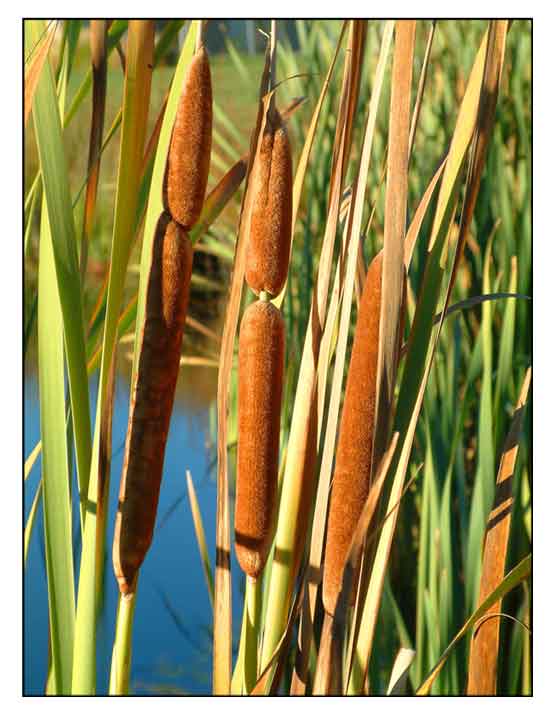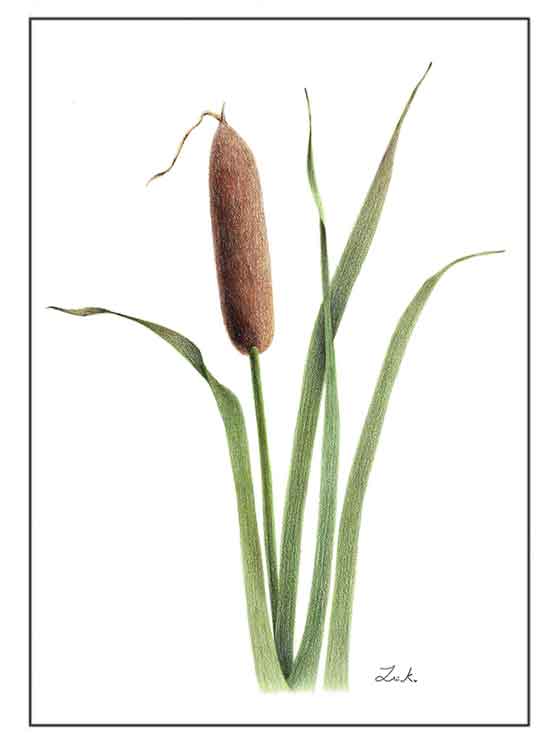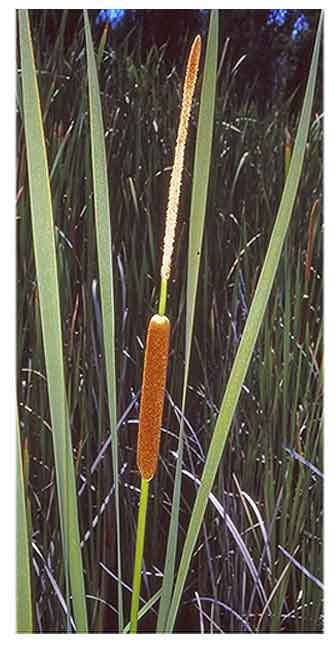 Gen info Gen info
- Typhaceae in the Philippines: Co's Digital Flora of the Philippines lists two native Typha species: Typha domingensis and Typha orientalis. Possibly present and naturalized if indeed present are T. elephantina and T. latifolia. (2)
- Typha is a genus of about 30 species of monocotyledonous flowering plants in the family Typhaceae.
- Typha orientalis is a perennial herbaceous plant in the genus Typha.
- Etymology: The genus name Typha derives from Greek word typhos, referring to its marsh habitat, or alternatively, from typhe, meaning "cat;s tail", which the plant's inflorescences resemble. The species epithet orientalis refers to its region of origin.
Botany
• Stems 1.3-2 m tall, stout. Leaves 40-70 cm × 4-9 mm, abaxially convex, transverse section semicircular. Male part of spikes 2.7-9 cm, with 1-3 deciduous bracts at base or occasionally in middle portion; female part of spikes not separated from male part, 4.5-15 cm, with 1 deciduous bract at base. Male flowers: stamens 3, rarely 2 or 4; anthers ca. 3 mm. Female flowers without bracteoles; ovary fusiform to lanceolate; stalk ca. 2.5 mm, slender; styles 1.2-2 mm; stigmas spatulate, 0.5-0.8 mm; hairs on stalk ca. as long as style. Fruit elliptic. (Flora of China)
 • A robust, perennial herbaceous aquatic plant up to 4 m high, with an underground creeping rhizome to c. 200 mm diameter, stems to 20 mm diam. Leaves: Thick narrow sword-shaped leaves grow in tufts of eight to ten, standing erect above the water at 1-3 m in length. Flowers: Flowering stems stand at 1.5-2 m tall, bearing cylindrical terminal spike inflorescences that are 25-50 cm long. Inflorescences are monoecious, each consist of an upper male part that is brownish in colour and a lower female part is dark brown in colour. Fruits: Fruits are about 5-8 mm long, with bristly white hairs arising from the middle, which aid in the dispersal of the fruits by wind. Upon contact with water, the fruit wall opens, releasing seeds into the water. (6) • A robust, perennial herbaceous aquatic plant up to 4 m high, with an underground creeping rhizome to c. 200 mm diameter, stems to 20 mm diam. Leaves: Thick narrow sword-shaped leaves grow in tufts of eight to ten, standing erect above the water at 1-3 m in length. Flowers: Flowering stems stand at 1.5-2 m tall, bearing cylindrical terminal spike inflorescences that are 25-50 cm long. Inflorescences are monoecious, each consist of an upper male part that is brownish in colour and a lower female part is dark brown in colour. Fruits: Fruits are about 5-8 mm long, with bristly white hairs arising from the middle, which aid in the dispersal of the fruits by wind. Upon contact with water, the fruit wall opens, releasing seeds into the water. (6)
Distribution
- Native to the
Philippines.
- Also native to China, Inner Mongolia, Japan, Kermadec Is., Korea, Manchuria, Mongolia, Myanmar, New South Wales, New Zealand North, New Zealand South, Norfolk Is., Northern Territory, Primorye, Queensland, Sakhalin, South Australia, Taiwan, Tasmania, Victoria, Western Australia. (1)
- A wetland plant that grows on the edges of ponds, lakes, salt marshes, and slow flowing rivers and streams.
Constituents
- Study for fatty acid composition yielded: palmitic acid 37-39%, oleic acid 39%, myristic acid 29-33%. Mineral composition (2017 and 2019) yielded: calcium 131.2 and 319; Fe 5.84 and 6.5, K 385 and 590.3, Mg 61.8 and 117.4, Mn0.11 and 4.4, Na 97.8 and 150, Se 0.71 and 0.28, with absence of Zn, Cr, and Cu.
(8)
Properties
- Pollen is considered astringent, diuretic, emmenagogue, galactagogue, and hemostatic.
- Studies have suggest antioxidant, anticancer, cytotoxic, apoptotic, biosorbent, anti-obesity properties.
Parts used
Leaves, whole plant.
 Uses Uses
Edibility
- Rhizomes are edible; raw or cooked, with a sweet flavor.
- Rhizomes
can be boiled and eaten like potatoes, or macerate and boiled to yield a sweet syrup. Base of mature stem is edible, raw or cooked. Young flowering stems are edible, raw or cooked, with a taste of sweet corn; also made into syrup; (5)
- Flowers are baked into cakes.
Folkloric
- No reported folkloric medicinal use in the Philippines.
- Internally, use for treatment of kidney stones, hemorrhage, painful menstruation, abnormal uterine bleeding, post-partum pains, abscesses. Externally, pollen used for treatment of tapeworms, diiarrhea, and injuries. (5)
- In Chinese medicine, used for stimulation of blood circulation, hypertension, and nerve soothing effects. Used for difficult urination, whooping cough, and allergic dermatitis.
Others
- Crafts: Leaves are used for roofs and walls and making kites; occasionally for canoe sails. (3) The entire or split stem is used for making coarse bags, baskets, and rope for furniture trimming. Leaves used for braiding. Split leaves used for making coiled baskets. Short, fluffy waste fibers from protruding heads sometimes used for stuffing pillows, toys, mattresses, etc. (4) (5)
- Paper / fiber: Fiber from the leaves and stems can use used for making paper. Root fibers can be used for making string. (5)
- Compost:
Stems make excellent addition to compost heap.
- Agroforestry:
Extensive root system makes for good stabilization of wet banks of rivers. Has phytoremediative used for removing various pollutants from soil and water. (5)
Studies
• Antioxidant / Polyphenol and Flavonoid Content: Study of water and methanol extracts yielded polyphenol content of 230.50 µg and 494.17 µg CE/mg ; flavonoid of 53.92 µg and 71.89 µg RE/mg, and flavonol of 2.89 µg and 7.04 µg CE/mg, respectively. TEAC of water and methanol extracts were 344.13 and 651.22 µM Trolox/mg; DPPH radical scavenging activity IC50s of 533.59 and 208.01 µg/mL; and reducing power of0.58 and 0.46, respecetively. Phenolic compounds may contribute directly to antioxidative action. (7)
• Activated Carbon for Removal of Chloramphenicol from Contaminated Waters: Study reports on a low-cost and efficient preparation of activated carbon (AC) from T. orientalis via phosphoric acid activation for chloramphenicol (CAP) removal from contaminated waters. Results showed in a realistic water environment, AC exhibited high CAP removal efficiency. The AC from T. orientalis showedbe an economical and efficient adsorbent CAP removal from aqueous solution. (9)
• Anticancer / Human Colon Adenocarcinoma HT29 Cells: Study evaluated the anticancer effect of methanol extract T. orientalis (METO) and its mechanism on human colon adenocarcinoma HT29 cells. The METO showed cytotoxic activity in a dose dependent manner, and induced G2/M cell cycle arrest and apoptosis in HT29 cells. The METO induced apoptosis was characterized by proteolytic activation of caspase-3, degradation of poly ADP ribose polymerase (PARP), and up-regulation of death receptor FAS and pro-apoptotic Bax expression. Results indicate cell cycle inhibition and apoptosis induction in HT29 cells, and potential for use in anticancer therapies. (10)
• SH21B / Polyherbal Anti-Obesity Mixture: SH21B is an anti-obesity composition of seven herbs: Typha orientalis, Scutellaria baicalensis, Prunus armeniaca, Ephedra sinica, Acorus gramineus, Polygala tenuifolia, and Nelumbo nucifera. It has been used for treatment of obesity in traditional medical clinis in Korea. SH21B significantly inhibited fat accumulation in 3T3-L1 adipocytes and reduced adipose tissue and serum triglycerides in higt fat diet-induced obese mice. SH21B affected more genes in the adipogenesis pathway, and significantly decreased expression of major transcription factors of the pathway and down-regulated lipid metabolizing enzymes involved in transport, uptake, and synthesis of lipids. (11)
Availability
- Wild-crafted.
- Seeds in the cybermarket. |

![]()






